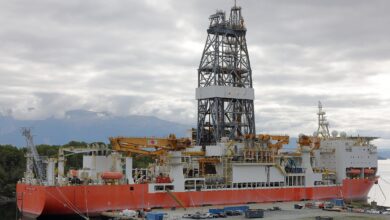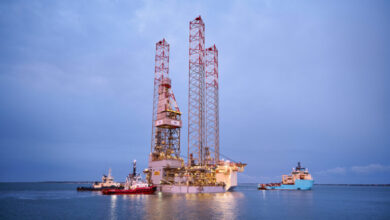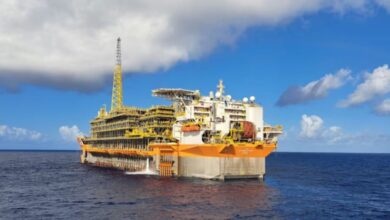Diamond Offshore develops Floating Factory drillship concept using lean manufacturing principles
By Kelli Ainsworth, Associate Editor

As part of its efforts to lower offshore drilling costs, Diamond Offshore has developed the Floating Factory drillship concept. The rig features a Huisman drill tower, a dual mud pit system and 50% more rig space than typical sixth-generation drillships, James Hebert, Director of Operations and Technical Support for Diamond Offshore, said. “We all agree that we need to reduce well delivery times and improve the economics to try to drive the costs of offshore development,” Mr Hebert said in a presentation on 14 March at the SPE/IADC Drilling Conference The Hague, The Netherlands. “We’re trying to take a step back from how we previously looked at rig designs and trying to see what we can do to improve.”
For example, Diamond approached the design process by looking at the drilling rig as a development tool. “For ultra-deepwater projects, you’re going to have to do completions and interventions, so you need to look at the entire well life cycle. That includes changing from one operational phase to the next,” Mr Hebert said. With this new design, the contractor aims to take as much of the transition between phases as possible off the critical path.
The company also approached the design by relying on lean manufacturing principles. “We always look at what we, as contractors, can do to reduce flat time,” Mr Hebert said. To develop the base design concept for the new rig, the company followed the Timwood model, which focuses on eliminating waste associated with transportation, inventory, movement, waiting, overproduction, over-processing and defects.
After developing the base design concept, the contractor then spent the first half of 2016 meeting with more than a dozen operators during what Mr Hebert referred to as a “voice of customer” process. “We got their input and thoughts on where they saw inefficiencies and what waste should we try and address,” he said. The contractor also sought out input from service companies on ways to make the drilling process more efficient.
The finalized concept is based on the Huisman 12000 design and includes a drill tower that enables tripping in unrestricted mode at 5,000 ft/hr in areas where there’s no surge and swab risk, such as open water. Although this tripping speed won’t always be possible, the tower also allows for 180-ft stands of pipe, compared with the more traditional 135-ft stands. This saves two connections per 1,000 ft of pipe, which translates to approximately six minutes saved per 1,000 ft of pipe.
Diamond also increased the length and width of the drillship design to create a large and flat deck. The Floating Factory design contains 50% more dedicated deck space than the average sixth-generation drillship. “You can walk from one end of the rig to the other without going on any stairs,” Mr Hebert said, which is a significant HSE benefit. “There are guys climbing four or five flights of stairs going from the top of the drill floor down to the main deck, and they’re just knackered by the end of their shift. That leads to shortcuts, which leads to injury and fatigue.” Along with increasing the deck size, Diamond also incorporated increased storage space into the drillship design. This change allows the contractor to keep more materials onboard the rig at a given time, reducing time and costs associated with loading and unloading supplies.
Like the increased storage space, the dual mud pit system reduces the time spent loading and unloading materials. It also saves time by eliminating the need to switch from one type of drilling fluid to another. The dual system consists of two separate flow lines and two shaker pits and individual charging, mud mixing and transfer systems. One pit would be used for water-based muds, while the other would be used for synthetic-based muds. In addition, the contractor could choose to keep both drilling and completion fluids on the rig.
Preliminary calculations suggest that the Floating Factory concept could shave 16.5 days from a 100-day well, on average. The bulk of this reduction would come from the high-speed tripping ability and the reduced connection time.
For more information about the Floating Factor, please see SPE/IADC 184650, “The Floating Factory Concept: Engineering Efficiencies Up Front to Reduce Deepwater Well Delivery Cost.”




